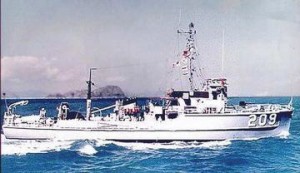Nearly all my 25-year career in the Navy, mostly in the reserves, was spent behind a desk. But just as every member of the Army and Marines is a rifleman at heart, every Navyman is a sailor. So it was with me. Although my advancement in the Navy was due to my expertise in public affairs and not my seamanship, my one tour of sea duty forever cemented my kinship with sailors everywhere.
The sea fascinated me from childhood. I read C.S. Forester’s Horatio Hornblower books and watched Victory at Sea on TV. After college I joined the Navy, got a crash course in seamanship and navigation in officers’ training and, with typical military logic, was stationed in Albuquerque, New Mexico. This was not what I had in mind when I joined the Navy. I volunteered for anything that would get me out of there and was transferred to a minesweeper based in Japan.
Minesweepers clear sea mines to prevent other ships from being blown up. Modern mines are triggered by the magnetism of a ship’s steel hull or the sound of its engines, so minesweepers are built of wood with mostly nonmagnetic equipment and quiet engines. The idea is for the ship to pass safely over a mine while the minesweeping gear it is towing –which pulses an electrical charge or makes noise – detonates the mine safely astern. This is an inexact science, so minesweepers are small and cheap.
The result is what one writer called “belligerent-looking yachts wearing grey paint.” At 144 feet long and 400 tons my ship, a coastal minesweeper, was one of the smallest ships in the Navy. Coastal minesweepers were named for birds and my ship was the USS WOODPECKER (MSC-209). We may have had the toughest crew in the Seventh Fleet: Our enlisted men wore a uniform patch with the ship’s name and felt compelled to defend it in every bar in town. (One of our sister ships was USS ALBATROSS (MSC-289), whose crew apparently had not read Coleridge’s Rime of the Ancient Mariner.)
My wife saw the ship for the first time when we returned from a cruise shortly after she arrived in Japan. She said: “You went to sea in that?”
Minesweeper sailors take a perverse pride in their tiny, rough-riding ships. Some cannot resist challenging larger ships as a gag. The captain of a minesweeper I was riding in a fleet exercise in the 1970s tweaked a nearby cruiser with the message “Your money or your life.” The cruiser replied: “Any attempt on either will result in world’s largest pile of matchsticks.”
Years later I visited an aircraft carrier and mentioned during dinner conversation that I had served on a 400-ton minesweeper. I was told: “That’s about how much we eat.”

